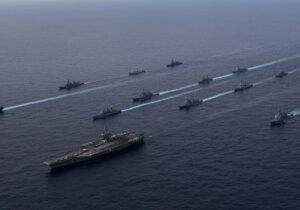Miracle of miracles—a moment of clarity struck amidst verbal sparring over American aid to Ukraine at the Republican debate in Simi Valley on September 27. As Ron DeSantis, Vivek Ramaswamy, Mike Pence, Nikki Haley, and Tim Scott argued over the correct levels of US military assistance to Kyiv, the moderator turned to an unlikely oracle: North Dakota Governor Doug Bergum. “We’re in a Cold War with China,” Bergum declared, “We’re in an economic war with agriculture and energy.” After repeating this conventional wisdom, he then offered an oft-overlooked statistic whose significance is difficult to overstate: “They’re also helping Iran get closer to nuclear weapons, which pushes all of the Middle East closer to China and Russia… At the core of all that is energy policy because China imports 10 million barrels of oil a day, they’re the largest importer in the world.”
This statistic flips longstanding strategic considerations on their head. In the closing days of World War II, Secretary of State Cordell Hull lauded Middle Eastern oil as “one of the world’s great prizes.” For that reason, President Eisenhower resolved during the Cold War that “should a crisis arise threatening to cut the Western world off from Mid East oil, we would have to use force.” Simply put, although the Soviet Union did not require Middle East oil to meet its own energy needs, the United States very much did need access to sustain its own economy and those of its European and Asian allies. Given the importance of Persian Gulf petroleum, then, it is little wonder the United States zealously courted Middle East allies, promised to protect the Saudi regime, intervened in the Iran-Iraq War, crushed Hussein’s armies in Desert Storm, and established major military bases across the region in the ensuing decades.
Except now, with the fracking revolution and Chinese dependency on Middle East oil, the situation is reversed. The United States is self-sufficient and, as the war in Ukraine shows, can even supply the energy needs of its allies. America’s superpower rival, by contrast, is parched for petroleum.
While interesting, what makes this reversal strategically momentous is the groundbreaking news that Israel and Saudi Arabia are inching closer toward a historic agreement to formalize relations (time will tell if the Hamas attack on October 7 will derail this development). Such a deal would obviously mark a new chapter (if not the end) of the Arab-Israeli conflict and would strengthen US-Saudi ties in the face of Chinese diplomatic overtures. However, it would also signal a pivot in US defense strategy in the region. As the Economist reports, the Biden administration views this deal as the creation of “a new-American-backed diplomatic and defense framework in the Middle East, built around the two regional powers.”
By crafting a Middle Eastern defense posture organized around two key US allies in the midst of a larger superpower rivalry, the Biden administration’s strategy calls to mind an earlier era of American security policy in the region. Spanning the presidencies of Lyndon Johnson, Richard Nixon, Gerald Ford, and Jimmy Carter, the Twin Pillars strategy emerged as a US response to the British withdrawal of military forces “east of Suez” in 1971. Faced with an apparent “vacuum” in the Middle East, US strategists rushed to stabilize the region against Soviet incursion and communist advances by extending aid, advisors, and military equipment to Saudi Arabia and, to a much greater extent, Iran. By fortifying these “pillars,” the thinking went, the United States could avoid undertaking a major military commitment to defend the region or stationing troops there amid the ongoing Vietnam War. Over the course of the 1970s, Saudi Arabia and Iran received a bewildering amount of US economic and military investment. For example, Washington increased arms exports from $1.4 billion in 1971 to $16 billion in 1975, roughly half of which went to Iran alone, following the Foreign Military Sales Act of 1968. This investment, in turn, helped fuel popular unrest against the Shah’s regime, thereby setting the stage for the Iranian Revolution.
To be sure, there are clear differences between the 1970s and our own time. China does not present the same ideological or military challenge as the Soviet Union. Buoyed by the economic rise of Asia, India, and (especially eastern) Europe, the world today is much more multilateral than back then. And, we are now, of course, on the other side of the politically contentious American wars in Afghanistan and Iraq.
Nevertheless, should a deal come to fruition, there would be three fundamental similarities:
- The United States in is a cold war with a Eurasian totalitarian superpower.
- Middle East oil would be a key factor in any military conflict between these superpowers.
- American global defense strategy depends on fortifying two allies with deep differences to shore up Middle Eastern security while US military hardware is deployed elsewhere in Europe and Asia.
Given these likenesses, it seems prudent to ask what lessons the United States can learn from its earlier experience propping up the Twin Pillars of the Persian Gulf. This seems especially important since that era ended with the disastrous collapse of the Shah’s regime in Tehran, the Soviet invasion of Afghanistan, and the seizure of the Grand Mosque in Mecca by Juhayman al-Otaibi’s Salafist radicals, leading to Carter issuing his eponymous doctrine to directly reassert US military primacy in the region in the 1980 State of the Union address. While there is not space to fully explore all the lessons this era holds for us today, two key observations are worth highlighting.
First, US strategists must avoid the trap of reverse leverage. Following the dictates of the Nixon Doctrine, American defense planners extended a tremendous amount of U.S.-made armaments to Saudi Arabia and Iran in the 1970s. The value of American conventional weapons transfers to Riyadh grew over 2,000 percent from 1970 to 1972, the same year Nixon signed the “blank check” agreement that permitted the Iranian monarch to purchase any US weapons system he wished, in any quantity, besides nuclear weapons. By the latter half of the decade, American overinvestment allowed the Shah to become—in the words of one RAND report—a “superclient” capable of extracting more and more concessions (weapons, loans, aid, diplomatic leeway) from Washington. This situation, in turn, empowered the Shah to pour resources into Iran’s military, which eventually led to inflation that helped destabilize his regime. If the United States is going to rely on Israel and Saudi Arabia to protect shared interests in the Middle East, it must find a way to avoid falling into a similar position of overreliance as it did Iran.
Second, the United States should be wary of being drawn into Israeli-Saudi bilateral disputes. The sheer amount of American largesse directed toward Riyadh and Tehran during the Twin Pillars era enabled each country to pursue massive modernization and public spending projects, emboldening the Shah to pursue Iranian political dominance of the Gulf. For example, Iranian troops seized Abu Musa Island from Sharjah, infuriating Iran’s Arab neighbors; Saudi Arabia, for its part, crushed Iran’s oil export market in 1977. Rather than working together in harmony, the Saudis and Iranians clashed constantly in the 1970s. Since the cultural, historical, and diplomatic divides between Israel and Saudi Arabia are even greater, then American policymakers should prepare to play an active role in mollifying disputes between its new Twin Pillars in the Middle East lest the entire security structure corrode over time due to regional rivalry. Indeed, the desert kingdom’s complex response to the Hamas attack testifies to the difficulty for US strategists who seek to reconcile the interests of these two new “pillars” of security in the Middle East.
Regardless, it is clear that a new era is dawning in US Middle East defense strategy under Biden. The alliance structure that emerges, whatever its title, will most certainly need to be up to the test.






 Sponsor a student for Christianity & National Security 2024
Sponsor a student for Christianity & National Security 2024